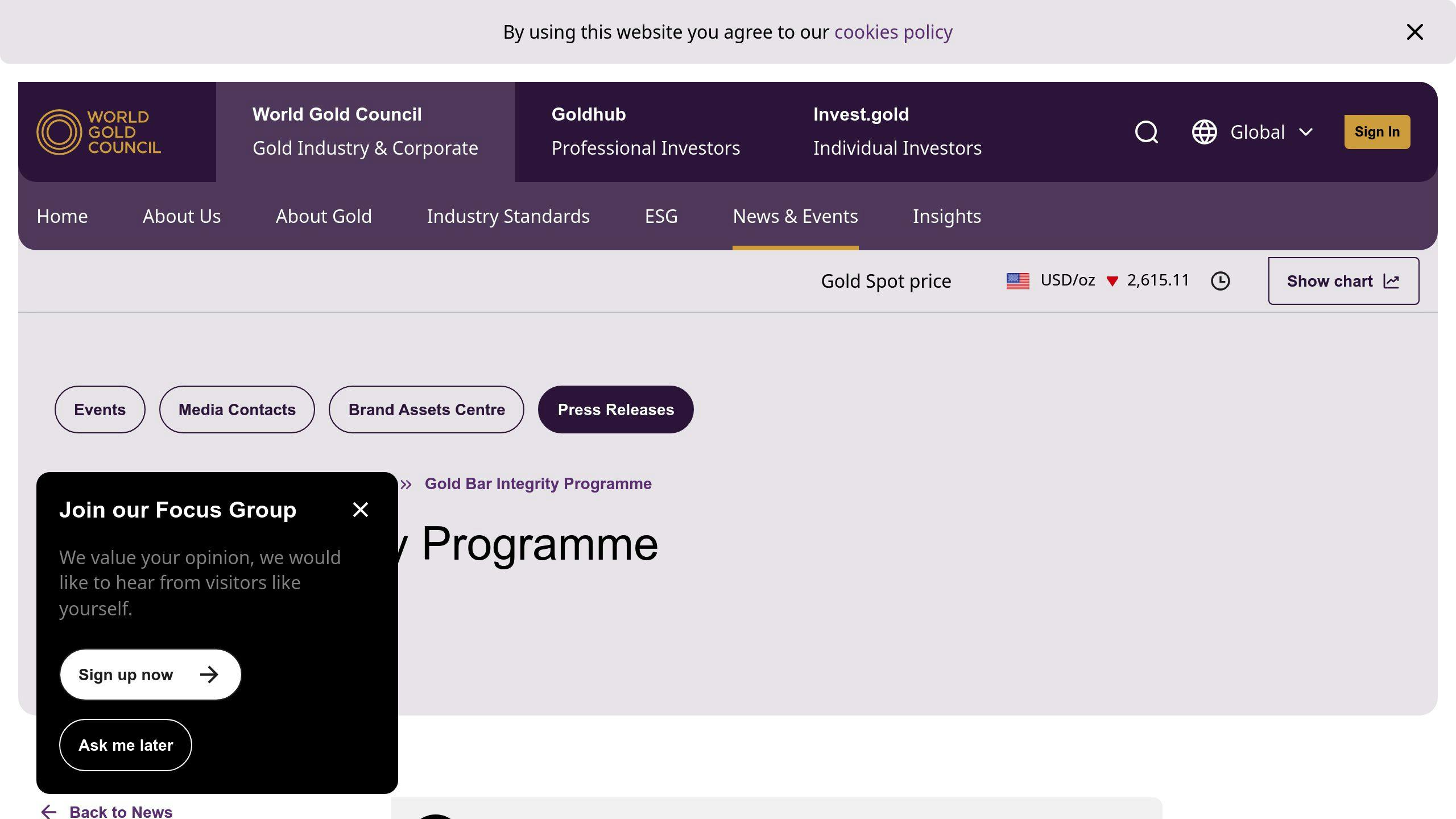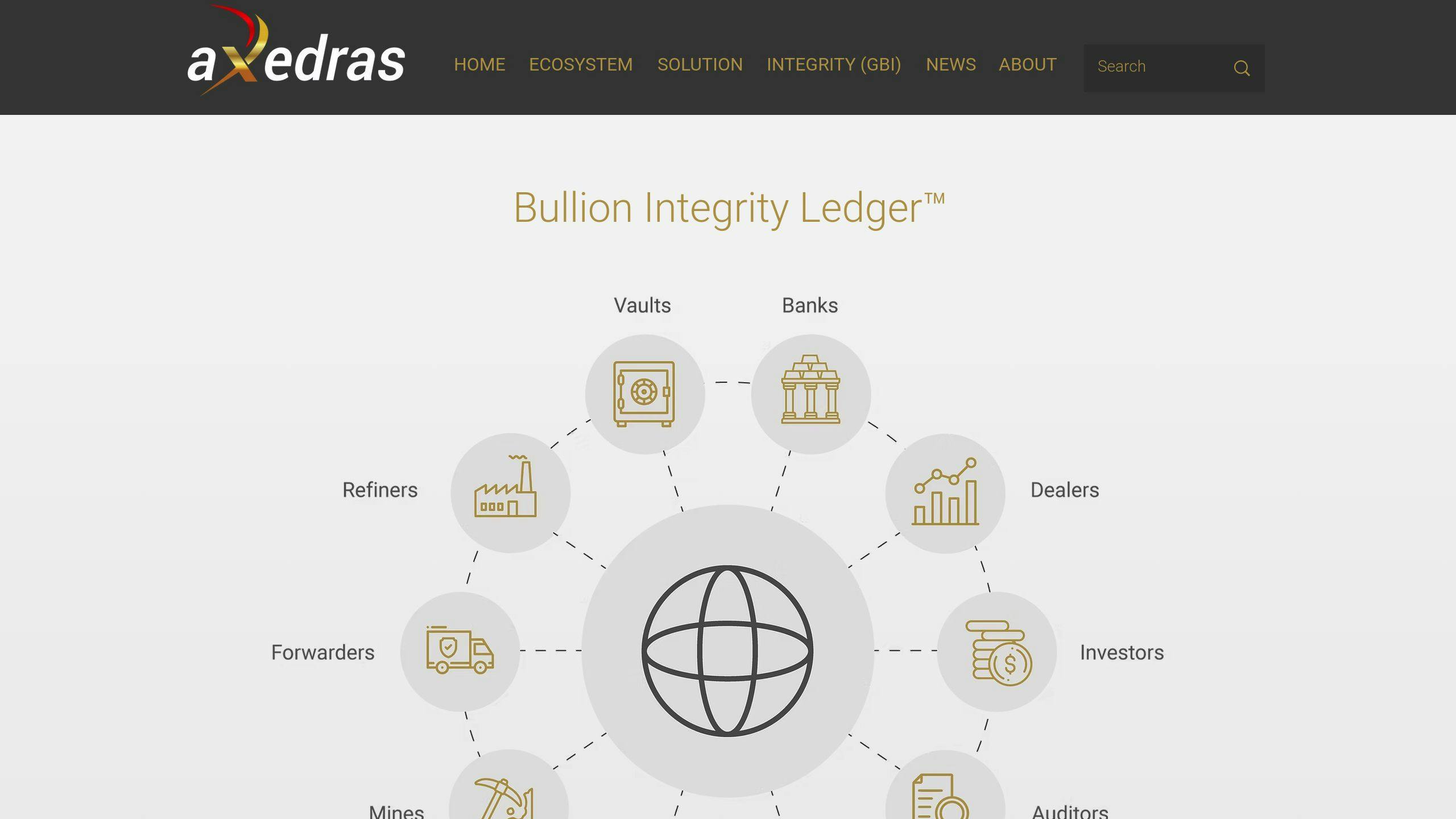Blockchain is transforming the precious metals industry by:
- Tracking every step from mine to store
- Preventing counterfeits
- Proving ethical sourcing
- Building consumer trust
Key initiatives:
-
Gold Bar Integrity Programme
- Uses blockchain to track gold bars
- Creates digital fingerprints for each bar
- Verifies origin and ESG credentials
-
aXedras Bullion Integrity Ledger™
- Tracks metal sources with blockchain
- Allows secure data sharing between partners
- Adopted by major industry players
-
Nora Sermez Jewelry
- Uses blockchain to prove recycled materials
- Tracks entire supply chain
- Builds customer trust through transparency
Benefits:
- Transparent supply chains
- Reduced counterfeiting
- Streamlined operations
- Increased trust
Challenges:
- High setup costs
- Scalability issues
- Regulatory compliance
- Data quality concerns
Despite challenges, blockchain is set to reshape the precious metals industry, bringing unprecedented transparency and efficiency.
Related video from YouTube
1. Gold Bar Integrity Programme

The London Bullion Market Association (LBMA) and World Gold Council (WGC) have launched the Gold Bar Integrity Programme. This initiative uses blockchain to track gold bars from mine to market.
Tracking Methods
The programme uses a blockchain system to record each step of a gold bar's journey. This creates a permanent, transparent record of the supply chain.
The system uses Alitheon's FeaturePrint technology. It creates a unique digital fingerprint for each gold bar using standard cameras or phones. No physical tags needed.
Source Verification
Verifying gold's origin is key to fighting illegal mining and ensuring ethical sourcing. The programme tackles this head-on:
- It creates a provenance network for gold transactions
- It enables real-time recording instead of manual audits
- It verifies the Environmental, Social, and Governance (ESG) credentials of gold
Supply Chain Records
The blockchain ledger is a central database for all gold bar data:
- It aims to record all transactions by major industry players
- Partners can securely access and share relevant data
- Each gold bar gets a digital passport that updates as it moves through the market
Ruth Crowell, CEO of LBMA, says:
"The international trade in wholesale, physical gold depends on confidence. The initiative announced today underlines the confidence that all participants in the market can have in the integrity and accountability of the gold they trade, and the gold they buy."
This programme is a big step forward in tracking precious metals. It sets new standards for transparency in the gold market, giving consumers and investors more confidence in their gold's authenticity and ethical sourcing.
2. aXedras Bullion Integrity Ledger

The aXedras Bullion Integrity Ledger™ is changing the game in the precious metals industry. This blockchain-based platform boosts transparency, traceability, and trust in the gold supply chain.
Metal Origin Tracking
The Bullion Integrity Ledger™ uses Distributed Ledger Technology (DLT) to check metal sources. Here's the lowdown:
- Suppliers can create digital provenance docs for mined or recycled products
- Each refined product gets a unique Integrity Certificate with provenance data
- The blockchain makes permanent, tamper-proof records of each gold bar's journey
This setup makes it tough for fake or unethically sourced gold to sneak into the market. During the pilot program, aXedras showed a fully digital, end-to-end case of gold flowing from mine to investors.
Data Sharing
The Bullion Integrity Ledger™ makes data sharing between supply chain partners a breeze:
- It's a private, permissioned B2B network - only legit organizations can join
- Members can share data directly with auditors and authorities
- Logistics companies can access digital bar lists and data sets for shipments
"AXEDRAS DEVELOPS A TRUSTED, BLOCKCHAIN-BASED PLATFORM TO DIGITALIZE B2B PROCESSES ALONG THE VALUE CHAIN OF PRECIOUS METALS: FOCUSING ON PRODUCT AND DATA INTEGRITY." - aXedras
Industry Adoption
The aXedras platform is catching on fast:
Over 30 organizations joined the pilot program, including 8 mines, 9 refiners, 4 carriers, and 10 banks or dealers. All 33 World Gold Council members, making up about 40% of global raw gold production, are on board with the Gold Bar Integrity platform.
David Tait, CEO of the World Gold Council, says:
"This ensures gold enters the Gold Bar Integrity platform 'at source' and is a major step in the digitalization of gold across the supply chain."
Benefits for Jewelry Industry
For companies like Nora Sermez Jewelry, focused on ethical sourcing and recycled materials, the Bullion Integrity Ledger™ is a game-changer:
- They can verify the ethical sourcing of gold for their handmade fine jewelry
- It's a way to show customers the authenticity and responsible sourcing of materials
- It digitalizes and streamlines logistics and business processes, potentially cutting costs and boosting efficiency
The aXedras Bullion Integrity Ledger™ is setting new standards in the precious metals industry. As it grows with industry leaders, it's set to reshape how we track, trade, and trust gold globally.
sbb-itb-d0b3b91
3. Nora Sermez Jewelry

Nora Sermez Jewelry is shaking up the luxury handmade fine gold jewelry market. How? By using blockchain to prove their materials are ethically sourced and their supply chain is crystal clear. It's a smart move that taps into the growing demand for sustainable luxury and eco-friendly bling.
Metal Sources
Nora Sermez isn't digging up new gold. Instead, they're giving old gold and platinum a second life. But how do they prove it's really recycled? That's where blockchain comes in.
Here's how it works:
1. Collection
They gather old gold from various sources - think unwanted jewelry and even electronic waste.
2. Verification
Each batch of recycled metal gets a unique digital ID on the blockchain. It's like a fingerprint for your future necklace.
3. Refining
The metals go through a purification process to meet top-notch quality standards.
4. Certification
The blockchain record gets updated to show the metal's purity and where it came from.
This approach does two big things: it proves the materials are legit, and it's way better for the planet. Recycling gold uses much less energy than mining new gold, which means fewer carbon emissions.
Supply Chain Steps
Nora Sermez uses blockchain to track every single step from start to finish. It's like a digital breadcrumb trail that customers can follow.
Here's what gets tracked:
1. Material Sourcing
Every batch of recycled metal or ethically sourced gemstone gets logged on the blockchain.
2. Design Phase
The design process is recorded, linking specific materials to each piece of jewelry.
3. Crafting
As artisans work their magic, they update the blockchain to show how raw materials become finished jewelry.
4. Quality Control
Each piece goes through tough quality checks, and the results are recorded on the blockchain.
5. Certification
A final blockchain entry wraps up the whole journey of the piece.
This level of transparency does two things: it builds trust with customers and proves that every piece lives up to Nora Sermez Jewelry's promises about ethics and sustainability.
Benefits and Limitations
Blockchain is shaking up the precious metals industry. It's bringing big changes, but it's not without its challenges. Let's break down the good and the not-so-good of using blockchain in precious metals supply chains.
Benefits
See-Through Supply Chains
Blockchain makes the precious metals journey crystal clear. Every step gets recorded on a shared ledger that can't be messed with. For companies like Nora Sermez Jewelry that care about ethical sourcing and recycled materials, this is huge.
Fake Products? Not a Chance
Once something's on the blockchain, it's there for good. This makes it super hard for fake precious metals to sneak into the supply chain. In an industry where real is everything, that's a big deal.
Smoother Operations
Blockchain cuts out a lot of paperwork and middlemen through smart contracts. This automation can save serious cash. Some folks in the industry think blockchain could slash transaction costs by up to 80%.
Building Trust
With blockchain, everyone can see what's happening. This builds trust between all the players in the supply chain. It's especially important now that buyers care more about where their stuff comes from and how it's made.
Limitations
Tough to Set Up
Getting blockchain to work with existing systems can be a headache and expensive. Many companies might need to overhaul everything they're doing now. That's no small task.
Growing Pains
As more people use blockchain, some networks might struggle to keep up. This could slow things down and make supply chains less efficient.
Rule Book Headaches
The precious metals world has a ton of rules. Making sure blockchain fits with all these rules across different countries? It's tricky.
Garbage In, Garbage Out
Blockchain keeps data safe, but it can't make sure the data was right to begin with. A 2018 study found only 15% of people thought their current systems could produce clean, trustworthy data. So, we need to be extra careful about what data goes in.
What the Experts Say
Deloitte US is pretty excited about blockchain:
"Access to reliable data can help mitigate all these risks thanks to the timely identification of issues and potential alternatives."
Publish What You Pay agrees:
"The undeniable potential of blockchain lies in its ability to enhance transparency, traceability, and efficiency within the precious metal supply chain."
How to Get Started
If you're thinking about using blockchain, start small. Try one blockchain feature, like tracking deliveries. This lets you dip your toe in without diving headfirst into the deep end.
As more companies jump on the blockchain bandwagon, we'll likely see systems that work better together and follow the same rules. This will help blockchain reach its full potential in the precious metals world.
Summary
Blockchain is shaking up the precious metals supply chain. It's bringing a new level of openness to the jewelry world, tackling big issues in how we source, track, and check precious metals from start to finish.
Take the Gold Bar Integrity Programme. It's a joint effort by the London Bullion Market Association and World Gold Council. They're using Alitheon's FeaturePrint tech to give each gold bar its own digital fingerprint. This means you can track and verify where the gold came from and its ESG status in real-time.
Then there's the aXedras Bullion Integrity Ledger™. It's catching on fast. Over 30 big players - mines, refiners, banks - are trying it out. And get this: all 33 World Gold Council members are on board. That's about 40% of global raw gold production. It's a big deal.
For smaller players like Nora Sermez Jewelry, blockchain is a game-changer. It lets them prove they're using ethical sources and recycled materials. They can show customers exactly where each piece came from and how it was made.
But it's not all smooth sailing. Switching to blockchain can be tricky and expensive. Companies need to overhaul their systems. There are also worries about data quality and following different rules in different countries.
Even so, the perks are hard to ignore. Blockchain could cut transaction costs by up to 80%. It makes fraud much harder. And it helps meet the growing demand for ethically sourced bling.
David Tait, CEO of the World Gold Council, puts it like this:
"This ensures gold enters the Gold Bar Integrity platform 'at source' and is a major step in the digitalization of gold across the supply chain."
Looking ahead, mixing blockchain with AI and IoT gadgets could make things even better. As more companies jump on board, we'll likely see systems that work together better and more standard ways of doing things. This means even more openness and efficiency in the precious metals world.


Leave a comment